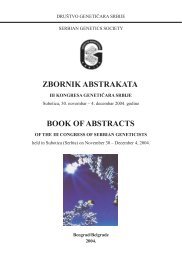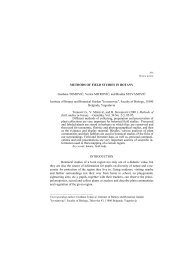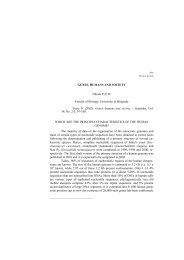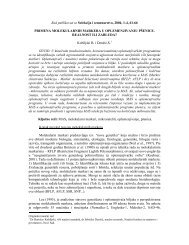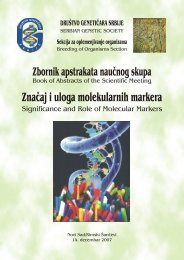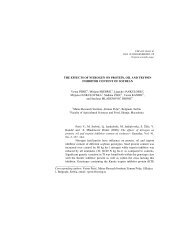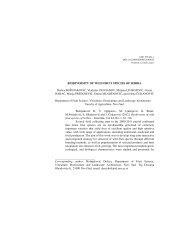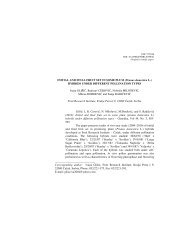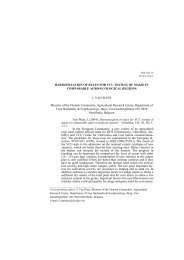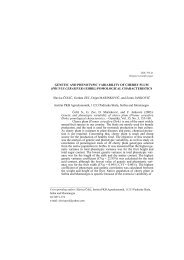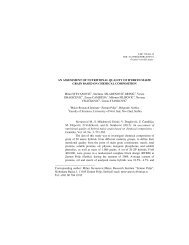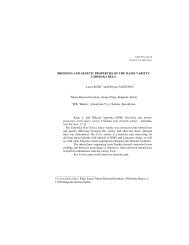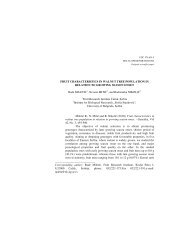The study of populations of hazelnut c. Avelana L. and Turkish ...
The study of populations of hazelnut c. Avelana L. and Turkish ...
The study of populations of hazelnut c. Avelana L. and Turkish ...
Create successful ePaper yourself
Turn your PDF publications into a flip-book with our unique Google optimized e-Paper software.
UDC 575: 634.54<br />
Original scientific paper<br />
THE STUDY OF POPULATIONS OF HAZELNUT C. avelana L. AND<br />
TURKISH HAZELNUT C. colurna L. AND THEIR SELECTION<br />
Rade MILETIĆ, Milisav MITROVIĆ, Milan RAKIĆEVIĆ, Miladin<br />
BLAGOJEVIĆ <strong>and</strong> Žaklina KARAKLAJIĆ-STAJIĆ<br />
ARI SERBIA. Fruit <strong>and</strong> Grape Research Centre, Čačak, Srbija<br />
Miletić R., M. Mitrović, M. Rakičević, M.Blagojević <strong>and</strong> Ž.<br />
Karaklajić - Stajić (2007): <strong>The</strong> <strong>study</strong> <strong>of</strong> <strong>populations</strong> <strong>of</strong> <strong>hazelnut</strong> C.<br />
avelana L. <strong>and</strong> <strong>Turkish</strong> <strong>hazelnut</strong> C. colurna L. <strong>and</strong> their selection.–<br />
Genetika, Vol. 39, No. 1, 13 - 22.<br />
Properties <strong>of</strong> <strong>populations</strong> <strong>of</strong> <strong>hazelnut</strong> C. avelana L. <strong>and</strong> <strong>Turkish</strong><br />
<strong>hazelnut</strong> C. colurna L. in different regions <strong>of</strong> Serbia were studied over<br />
1998 – 2005. Round-fruit selections suitable for c<strong>and</strong>y industry were<br />
concurrently singled out. Populations <strong>of</strong> <strong>hazelnut</strong> <strong>and</strong> <strong>Turkish</strong> <strong>hazelnut</strong> are<br />
characterized by small or medium large fruits with round shape index <strong>and</strong><br />
kernel index ranging from 0.77 – 0.89 <strong>and</strong> 0.78 – 0.84 respectively.<br />
Singled out selections <strong>of</strong> <strong>hazelnut</strong> <strong>and</strong> <strong>Turkish</strong> <strong>hazelnut</strong> have<br />
averagely medium large fruits <strong>and</strong> kernel. Round shape index <strong>of</strong> fruits <strong>and</strong><br />
kernel <strong>of</strong> <strong>hazelnut</strong> amount to 0.98 (1.01 – 0.91) <strong>and</strong> 0.99 (1.00 – 0.96)<br />
respectively, whereas the same parameter in <strong>Turkish</strong> <strong>hazelnut</strong> amounts to<br />
0.99 (0.99 – 0.97) <strong>and</strong> 0.98 (0.98 – 0.97). Average fruit weight <strong>of</strong> the<br />
singled out selections is 1.79 g (<strong>hazelnut</strong>) <strong>and</strong> 1.74 g (<strong>Turkish</strong> <strong>hazelnut</strong>).<br />
Average kernel mass is 0.75 – 0.70 g. i.e. kernel ratio in <strong>hazelnut</strong> <strong>and</strong><br />
<strong>Turkish</strong> <strong>hazelnut</strong> amounts to 41% <strong>and</strong> 40.2% respectively. <strong>The</strong> mineral<br />
matter content in the kernel <strong>of</strong> the selections amounted to 2.4% <strong>and</strong> 2.3%<br />
_______________________________<br />
Corresponding author: Rade Miletić, ARI Serbia Fruit <strong>and</strong> grape research Centre, 32000<br />
Čačak, Serbia
14 GENETIKA, Vol. 39, No. 1, 13-22, 2007.<br />
respectively. Raw proteins content ranged from 13.8% - 12.4%<br />
respectively, <strong>and</strong> oil content ranged from 47.7 – 50.2% respectively. <strong>The</strong><br />
majority <strong>of</strong> indicators under in situ conditions suggest that all selections<br />
singled out from the population deserve attention with objective <strong>of</strong> more<br />
intensified propagation <strong>and</strong> wider introduction into commercial<br />
production. It particularly refers to the round shaped kernel which is the<br />
most suitable for the c<strong>and</strong>y industry.<br />
Key words: Population, <strong>hazelnut</strong>, <strong>Turkish</strong> <strong>hazelnut</strong>, fruit, round<br />
shape index.<br />
INTRODUCTION<br />
By its importance within the group <strong>of</strong> kernel fruits <strong>hazelnut</strong> ranks second.<br />
It has high quality fruits with good aroma, which recommends it for the c<strong>and</strong>y<br />
industry. Current forms <strong>of</strong> <strong>hazelnut</strong> <strong>and</strong> <strong>Turkish</strong> <strong>hazelnut</strong> are spontaneously<br />
widespread in the nature, representing a very rich genetic pool, significant for the<br />
selection. Biodiversity, pomological <strong>and</strong> technical properties <strong>of</strong> <strong>hazelnut</strong> <strong>and</strong><br />
<strong>Turkish</strong> <strong>hazelnut</strong> were studied under diverse agroecological conditions by<br />
MITRESKI et al., (1983), MANUŠEV (1988), MITROVIĆ et al., (1997) MILETIĆ et al.,<br />
(1997) etc. <strong>The</strong>se studies resulted in selections which were described by PEJKIĆ<br />
(1980), INIĆ-TODOROVIĆ (1987), KRSTIĆ-PAVLOVIĆ et al., (1990), MILETIĆ et al.,<br />
(2005). <strong>The</strong> stated researchers highlight high quality <strong>and</strong> their dietory <strong>and</strong> dietarytherapeutic<br />
value <strong>of</strong> the fruits.<br />
Being suitable for production <strong>of</strong> biologically high quality food, the fruits<br />
<strong>of</strong> <strong>hazelnut</strong> <strong>and</strong> <strong>Turkish</strong> <strong>hazelnut</strong> are outst<strong>and</strong>ing raw material for this very<br />
purpose. <strong>The</strong> objectives <strong>of</strong> <strong>hazelnut</strong> selection are maintenance <strong>of</strong> the current<br />
germplasm, breeding <strong>and</strong> establishment <strong>of</strong> commercial plantings. New<br />
requirements <strong>of</strong> the <strong>hazelnut</strong> processing industry refer mainly to developing<br />
cultivars with somewhat smaller, roundish-shaped fruits. Special attention has been<br />
devoted to the selection <strong>of</strong> <strong>hazelnut</strong> <strong>and</strong> <strong>Turkish</strong> <strong>hazelnut</strong>, in compliance with the<br />
dem<strong>and</strong>s <strong>of</strong> the c<strong>and</strong>y industry.<br />
MATERIALS AND METHODS<br />
<strong>The</strong> investigations were conducted on the wide territory <strong>of</strong> the central.<br />
eastern <strong>and</strong> east-southern Serbia where <strong>hazelnut</strong> <strong>and</strong> <strong>Turkish</strong> <strong>hazelnut</strong> are more<br />
widely spread. <strong>The</strong> paper presents major properties <strong>of</strong> the studied <strong>populations</strong> as<br />
well as the properties <strong>of</strong> the round shaped fruit selections singled out from the<br />
population. More vigorous, winter hardy, vital, high <strong>and</strong> regular cropping bushes<br />
<strong>and</strong> trees resistant to Curculium nucum were particularly studied. Furthermore, a<br />
special attention was devoted to fruit size, shape, fruit <strong>and</strong> kernel weight <strong>and</strong><br />
chemical composition <strong>of</strong> the fruits.<br />
Five <strong>hazelnut</strong> <strong>and</strong> <strong>Turkish</strong> <strong>hazelnut</strong> trees that gave the best results over<br />
1998 – 2005 were singled out from a large number <strong>of</strong> bushes. <strong>The</strong> collected fruits
R.MILETIĆ et. al.: STUDY OF POPULATION OF HAZELNUT 15<br />
were analyzed. i.e. fruit <strong>and</strong> kernel size (length, width <strong>and</strong> thickness) were<br />
determined by a calliper, whereas fruit <strong>and</strong> kernel weight were measured on a<br />
technical precision balance. Round shape index <strong>of</strong> fruit <strong>and</strong> kernel was calculated<br />
by the formula I = {(width + thickness):2} : length, SIMOSKI (1971). Oil content<br />
was determined by the nuclear magnetic resonance method, whereas raw proteins<br />
were assessed by Kjendal <strong>and</strong> mineral matter content by the burn method.<br />
RESULTS<br />
Hazelnut (C. avelana L.) <strong>and</strong> <strong>Turkish</strong> <strong>hazelnut</strong> (C. colurna L.) are widely<br />
spread in the region <strong>of</strong> Serbia. Both are mainly grown in phytocenoses with<br />
different wood plants as well as in homogenous surroundings. Forms <strong>of</strong> C.<br />
avelana L. <strong>and</strong> C. colurna L. developed spontaneously in nature are <strong>of</strong> generative<br />
origin <strong>and</strong> they are very important genetic pool.<br />
Studied <strong>populations</strong> <strong>of</strong> <strong>hazelnut</strong> have either small or medium large fruits.<br />
Average dimensions (length x width x thickness) are as follows: 17.2 (21.0-13.4) x<br />
13.8 (16.1-10.7) x 12.8 (16.7-9.2) mm. Kernel dimensions: 12.1 (13.5-10.7) x 8.8<br />
(12.5-6.7)x 7.7 (12.9-7.3) mm. Fruit dimensions <strong>of</strong> C. colurna L.: 14.7 (17.5-12.0)<br />
x 14.1 (16.5-11.5) x 12.1 (16.0-9.3) mm. Kernel dimensions <strong>of</strong> C. colurna L. : 11.5<br />
(13.0-10.2) x 10.2 (12.6-7.2) x 9.2 (12.5-5.0) mm (Table 1).<br />
Average values <strong>of</strong> fruit <strong>and</strong> kernel shape index <strong>of</strong> <strong>hazelnut</strong> amount to 0.77<br />
(1.03-0.58) <strong>and</strong> 0.78 (1.00-0.46) respectively. As for C. avelana L. these values are<br />
0.89 (1.04-0.66), i.e. 0.84 (1.02-0.53). <strong>The</strong> fruits <strong>of</strong> the C. avelana L. are mainly<br />
elongated. It is similar with the C. colurna L. population. However, as the fruits <strong>of</strong><br />
<strong>Turkish</strong> <strong>hazelnut</strong> are larger <strong>and</strong> their round shape index is higher, fruit shape tends<br />
to be roundish. Typically roundish fruits as well as their kernel (I=1.00) are rarely<br />
found in the stated <strong>populations</strong>.<br />
Average fruit weight <strong>of</strong> C. avelana L. is 1.02 g (1.40 – 0.42), kernel<br />
weight 0.34 (0.51 – 0.09 g) <strong>and</strong> kernel ratio amounts to 33.3% (37-12.8%). As for<br />
C. avelana L., the values are as follows: 1.15 g (1.55-0.94 g); 0.32 g (0.56-0.22 g);<br />
27.8% (39.2-22.2%). Hollow fruits as well as the incidence <strong>of</strong> damage caused by<br />
Curculium nucum is more frequent in the population <strong>of</strong> C. colurna L. <strong>and</strong> it ranges<br />
from 10.6% (17.7-0.0%), i.e. 3.9% (13.8-0.0%). As regards the <strong>populations</strong> <strong>of</strong> C.<br />
avelana L., these values are more pronounced amounting to 1.9% (4.4-0.0), i.e.<br />
0.37% (1.5-0.0%).<br />
In respect <strong>of</strong> the contents <strong>of</strong> mineral matters <strong>and</strong> raw proteins, the kernel<br />
<strong>of</strong> C. avelana L. are more rich in comparison with C. colurna L. - 2.02% (2.4-<br />
1.1%) <strong>and</strong> 12.8% (15.5-9.6%) respectively (for C. avelana L.); 1.9% (2.3-1.6%)<br />
<strong>and</strong> 12.6% (14.4-10.6%) respectively (for C. colurna L.). In contrast to that, the<br />
kernel <strong>of</strong> C. colurna L. has higher oil content 52.3% (65.5-48.6%) compared to C.<br />
avelana L. (51.4-36.0%, 41.5% on average), table 2.
16 GENETIKA, Vol. 39, No. 1, 13-22, 2007.<br />
Table 1. Fruit size <strong>and</strong> shape in yx <strong>and</strong> yy in respective <strong>populations</strong><br />
Tabela 2. Fruit weight <strong>and</strong> chemical composition <strong>of</strong> yx <strong>and</strong> yy in respective <strong>populations</strong>.
R.MILETIĆ et. al.: STUDY OF POPULATION OF HAZELNUT 17<br />
Selections <strong>of</strong> C. avelana L. singled out from the population that meet<br />
basic criteria related to fruit shape have averagely medium large fruits (16.5 (17.6-<br />
12.0) x 16.4 (18.3-12.2) x 15.9 (18.0-11.6) mm) <strong>and</strong> kernel 12.4 (13.0-10.5) x 12.4<br />
(13.2-10.5) x 12.1 (13.0-10.0) mm. On the other h<strong>and</strong>, fruits <strong>of</strong> C. colurna L. are<br />
somewhat larger – 18.1 (19.6-16.9) x 17.9 (19.1-16.8) x 17.8 (19.4-16.4), kernel<br />
amounting averagely to 12.2 (13.0-11.5) x 12.0 (12.8-11.3) x11.9 (12.5-11.3) mm.<br />
Round shape index for fruits <strong>and</strong> kernel <strong>of</strong> C. avelana L. amounts averagely to<br />
0.98 (1.01-0.91) <strong>and</strong> 0.99 (1.00-0.96) respectively, whereas for C. colurna L. the<br />
values are 0.99 (0.99-0.97) <strong>and</strong> 0.98 (0.98-0.97) respectively. As for this parameter<br />
the fruits <strong>of</strong> the selections are approximately or typicaly roundish, table 3.<br />
Tabela 3. Fruit <strong>and</strong> kernel size <strong>and</strong> shape <strong>of</strong> the selections singled out from the respective<br />
<strong>populations</strong><br />
Fruit <strong>and</strong> kernel weight <strong>of</strong> the selections is different, though averagely<br />
approximate in values. Thus, average fruit weight <strong>of</strong> C. avelana L. <strong>and</strong> C. colurna<br />
L. amounts to 1.79 g (2.21-0.95 g) <strong>and</strong> 1.74 g (2.29-1.28 g) respectively. <strong>The</strong><br />
kernel weight form C. avelana L. <strong>and</strong> C. colurna L. amount to 0.75 g (0.93-0.32 g)<br />
<strong>and</strong> 0.70 g (0.85-0.56 g) respectively, with the kernel ratio ranging from 46.2-<br />
33.7%, 41.0% on average, <strong>and</strong> 43.9-36.7%, 40.2% respectively. Hollow fruits<br />
amount to 0.5% (1.4-0.0) <strong>and</strong> 0.56% (1.2-0.0) respectively. Curculium nucum was<br />
recorded only in one selection <strong>of</strong> C. avelana L. <strong>and</strong> in two selections <strong>of</strong> C. colurna
18 GENETIKA, Vol. 39, No. 1, 13-22, 2007.<br />
L.. Mineral matter content in the kernel <strong>of</strong> the selections ranges from 2.7-2.0%,<br />
2.4% on average (C. avelana L.) <strong>and</strong> 2.7-1.9%, 2.3% (C. colurna L.). Soluble<br />
proteins content amounts to 13.8% (16.3-11.0%) <strong>and</strong> 12.4% (14.4-10.9)<br />
respectively, whereas oil content is 47.7% (51.7-43.9%) <strong>and</strong> 50.2% (53.1-47.7%)<br />
respectively (Table 4).<br />
Tabela 4. Fruit weight <strong>and</strong> chemical composition <strong>of</strong> kernel <strong>of</strong> the selections singled out from<br />
the respective <strong>populations</strong><br />
DISCUSSION<br />
<strong>The</strong>re are many bushes <strong>and</strong> trees with different pomological, biological<br />
<strong>and</strong> productive properties owing to the generative method <strong>of</strong> propagation within<br />
the <strong>populations</strong> <strong>of</strong> C. avelana L. <strong>and</strong> C. colurna L..<br />
MITRESKI et al.. (1983) state that fruit dimensions <strong>of</strong> the types singled out<br />
from the <strong>populations</strong> <strong>of</strong> C. avelana L. are 17.0-23.4x16.0-19.6x12.7-16.0 mm,<br />
fruit weight .45-2.08 g, kernel weight 0.48-1.15 g <strong>and</strong> kernel ratio 1.0-53.0%. On<br />
the Pešter plateau, PEJKIĆ (1980) made a selection <strong>of</strong> forms <strong>of</strong> C. avelana L. with<br />
fruit length ranging from 14.4 – 22.1, fruit width 14.1 – 16.9 mm <strong>and</strong> fruit weight<br />
1.13 – 1.51 g. It is similar with the fruits <strong>of</strong> C. colurna L. - NINIĆ-TODOROVIĆ<br />
(1987) reports biotypes with fruit size 16.4-18.6x14.4-17.8x11.0-15.8 mm, fruit<br />
weight 1.17-2.54 g <strong>and</strong> kernel weight 0.52 - 0.71 g. Within the studies <strong>of</strong>
R.MILETIĆ et. al.: STUDY OF POPULATION OF HAZELNUT 19<br />
biodiversity <strong>of</strong> C. colurna L. in Serbia MITROVIĆ et al.. (1997, 2001) reported<br />
properties for 11 <strong>and</strong> 7 genotypes <strong>of</strong> C. avelana L. <strong>and</strong> C. colurna L. respectively<br />
singled out from the selections <strong>of</strong> the central <strong>and</strong> the eastern Serbia. <strong>The</strong> authors<br />
state the following values <strong>of</strong> fruit size, kernel size <strong>and</strong> fruit weight, kernel weight<br />
<strong>and</strong> kernel ratio: 13.8-19.1x11.6-19.1x9.0-16.7 mm, 11.3-15.4x8.0-13.4x5.7-10.2<br />
mm, 0.63 - 2.86 g, 0.24 - 0.86 g <strong>and</strong> 25.9 - 38.1% respectively. In their studies<br />
MILETIĆ et al., (2005) presented eight selections <strong>of</strong> C. colurna L. <strong>and</strong> C. avelana L.<br />
each that attract attention. Kernel content in C. avelana L. ranges from 27.9% to<br />
46.2% <strong>and</strong> in C. colurna L. from 30.7 to 40.8%.<br />
All stated selections have typically elongated fruits, which corresponds<br />
with our results which suggest that elongated fruits dominate <strong>populations</strong> <strong>of</strong> C.<br />
avelana L. <strong>and</strong> C. colurna L. with the exception <strong>of</strong> the selection “Dučalovići”<br />
singled out by MITROVIĆ et al. (1997). By its properties, this selection is close to<br />
the dem<strong>and</strong>s <strong>of</strong> the c<strong>and</strong>y industry <strong>and</strong> high quality fruits. It also confirms the<br />
statement that genotypes with roundish fruits that are suitable for the chocolate<br />
industry may be found in the <strong>populations</strong>. HLIŠČ (1971) reports that round shape<br />
index in such fruits amounts to 1.0, whereas SIMOSKI (1971) reports the value 0.94<br />
for the parameter. According to these criteria, the stated selections are highly<br />
suitable for the c<strong>and</strong>y industry. Hollow fruits, irrespective <strong>of</strong> the incidence <strong>of</strong><br />
parasites, are caused by various factors, MANUŠEV (1988). <strong>The</strong> incidence <strong>of</strong><br />
Curculium nucum is certainly negative <strong>and</strong> a limiting factor for more intensive<br />
growing <strong>of</strong> such selections.<br />
Fresh <strong>hazelnut</strong> fruits are complex <strong>and</strong> high calorific value food with high<br />
dietary value, which is confirmed by the presented results <strong>of</strong> the selections <strong>of</strong> C.<br />
colurna L. <strong>and</strong> C. avelana L. singled out from the respective <strong>populations</strong>. <strong>The</strong>se<br />
correspond to the reports <strong>of</strong> KRSTIĆ-PAVLOVIĆ (1990), MILETIĆ et al., (1997,<br />
2005), NINIĆ-TODOROVIĆ (1987), MITROVIĆ et al., (1997), etc.<br />
As for the chemical composition <strong>of</strong> kernel <strong>of</strong> C. colurna L. <strong>and</strong> C.<br />
avelana L. it is not in correlation with the st<strong>and</strong>ard found in widely grown<br />
cultivars, MILETIĆ (1994), which does not affect their value <strong>and</strong> potential for both<br />
for fresh use <strong>and</strong> processing. Besides, <strong>populations</strong> <strong>of</strong> <strong>hazelnut</strong> are largely found in<br />
ecologically favorable environment <strong>and</strong> consequently <strong>hazelnut</strong> fruits may be<br />
described as biologically valuable food. Additionally, both C. avelana L. <strong>and</strong> C.<br />
colurna L. grow <strong>and</strong> produce fruits spontaneously in natural surroundings without<br />
a special cultivation <strong>and</strong> pest management. <strong>The</strong>se facts speak in favour <strong>of</strong><br />
beneficial values <strong>of</strong> fruits <strong>of</strong> <strong>hazelnut</strong> that recommend them for nutrition, which is<br />
certainly a special advantage <strong>of</strong> fruits <strong>of</strong> the Corylus genus. <strong>The</strong>re are favorable<br />
conditions in our country for the establishment <strong>of</strong> collection plantings with the<br />
aforementioned selections in high altitude <strong>and</strong> high humidity regions, at the foot <strong>of</strong><br />
big mountains, near mountain streams <strong>and</strong> in river valleys. <strong>The</strong> advantage <strong>of</strong> such<br />
regions are longer winter <strong>and</strong> snow periods along with relatively late snow melting<br />
which provide water for the optimal growth <strong>of</strong> fruits <strong>and</strong> kernel as well as for the<br />
regular cropping.
20 GENETIKA, Vol. 39, No. 1, 13-22, 2007.<br />
CONCLUSION<br />
Within the studies <strong>of</strong> C. avelana L. <strong>and</strong> C. colurna L. over 1998 – 2005<br />
some selections with outst<strong>and</strong>ing properties were singled out.<br />
Populations <strong>of</strong> C. avelana L. <strong>and</strong> C. colurna L. are characterized by small<br />
to medium large fruits. Round shape index <strong>and</strong> kernel shape index <strong>of</strong> C. avelana L.<br />
amount to 0.77 <strong>and</strong> 0.78 respectively, <strong>and</strong>, in C. colurna L., 0.89 <strong>and</strong> 0.84<br />
respectively. Average fruit weight, kernel weight <strong>and</strong> kernel ratio <strong>of</strong> C. avelana L.<br />
fruits are 1.02 g, 0.34 g <strong>and</strong> 33.3% respectively. As for, C. colurna L. these<br />
parameters are as follows: 1.15 g, 0.32 g <strong>and</strong> 27.8% respectively. Hollow fruits as<br />
well as damage caused by Curculium nucum in the C. colurna L. population are<br />
10.6%, i.e. 3.9% on average, whereas in C. avelana L. the corresonding value is<br />
1.9% (4.4-0.0) <strong>and</strong> 0.37%. Average mineral matters, raw proteins <strong>and</strong> oil contents<br />
in the kernel <strong>of</strong> C. avelana L. are as follows: 2.4%, 13.8% <strong>and</strong> 47.7% respectively.<br />
<strong>The</strong> same parameters in C. colurna L. are as follows: 2.3%, 12.4% <strong>and</strong> 50.2%, 0%,<br />
respectively.<br />
Fruits <strong>and</strong> kernel <strong>of</strong> the selections <strong>of</strong> C. avelana L. <strong>and</strong> C. colurna L.<br />
singled out from the respective <strong>populations</strong> are mainly medium large. Round shape<br />
index <strong>of</strong> the fruits <strong>and</strong> kernel <strong>of</strong> C. avelana L. amounts to 0.98 (1.01-0.91) <strong>and</strong><br />
0.99 (1.00-0.96) respectively, whereas for C. colurna L. the values are 0.99 (0.99-<br />
0.97) <strong>and</strong> 0.98 (0.98-0.97) respectively. Average fruit weight in C. avelana L.is<br />
1.79 g (2.21-0.95 g) <strong>and</strong> 1.74 g (2.29-1.28 g) in C. colurna L.. Kernel weight - 0.75<br />
g (0.93-0.32 g) <strong>and</strong> 0.70 g (0.85-0.56 g) respectively, with kernel ratio 41.0%<br />
(46.2-33.7%) <strong>and</strong> 40.2% (43.9-36.7%) respectively. Hollow fruits are 0.5% (1.4-<br />
0.0) <strong>and</strong> 0.56% (1.2-0.0) on average, respectively. Curculium nucum was recorded<br />
only in one selection <strong>of</strong> C. avelana L. <strong>and</strong> in two selecitons <strong>of</strong> C. colurna L..<br />
Mineral matter content in the kernel <strong>of</strong> the selections <strong>of</strong> C. avelana L. <strong>and</strong> C.<br />
colurna L. amounts averagely to 2.4% (2.7-2.0%) <strong>and</strong> 2.3% (2.7-<br />
1.9%)respectively.<br />
Raw proteins content in C. avelana L. <strong>and</strong> C. colurna L. amount to13.8%<br />
(16.3-11.0%) <strong>and</strong> 12.4% (14.4-10.9) respectively <strong>and</strong> oil content is 47.7% (51.7-<br />
43.9%) <strong>and</strong> 50.2% (53.1-47.7%) respectively.<br />
<strong>The</strong> majority <strong>of</strong> indicators under in situ conditions suggest that all<br />
selections singled out from the population deserve attention with objective <strong>of</strong> more<br />
intensified propagation <strong>and</strong> wider introduction into commercial production. It<br />
particularly refers to the round shaped kernel which is most suitable for the c<strong>and</strong>y<br />
industry.<br />
Received July 28 th , 2006<br />
Accepted December 18 th , 2006
R.MILETIĆ et. al.: STUDY OF POPULATION OF HAZELNUT 21<br />
REFERENCES<br />
KRSTIĆ-PAVLOVIĆ N., M. VELIČKOVIĆ, i S. JELAŠIĆ (1990): Proučavanje lekovitih sastojaka u<br />
samonikloj i nekim sortama leske. Jugoslovensko voćarstvo, 91-92:57-62.<br />
HLIŠČ T. (1971): Prilog poznavanju rodnosti ikakvoće plodova nekih sorti lešnika u uvetima Slavonskih<br />
Goric. Jugoslovensko voćarstvo, 17-18:211-216.<br />
MANUŠEV B. (1988): Uzgoj leske, Zadrugar, Sarajevo, 1-104.<br />
MILETIĆ R., M. MITROVIĆ, G. ĐURIĆ, <strong>and</strong> N. MIĆIĆ (1997): Biological<br />
Potential <strong>of</strong> European Filbert (C. avelana L) Growing wild in Eastern Serbia. Acta<br />
Horticulturae, 445:223-228.<br />
MILETIĆ R. (1994): Uporedna proučavanja plodova plemenitih sorti leske s plodovima šumske i mečje<br />
leske, Jugoslovensko voćarstvo, 105-106:21-25.<br />
MILETIĆ R., M. ŽIKIĆ N. , MITIĆ, <strong>and</strong> R.NIKOLIĆ (2005): Pomological characteristics <strong>of</strong> suprerior<br />
selections <strong>of</strong> european filbert (C.avelana L.) <strong>and</strong> turkish hazel (C. Colurna L.). Genetika, v.<br />
37, 2:103-111.<br />
MITREVSKI Z., B. RISTEVSKI, <strong>and</strong> B. KOLČEVSKI (1983): Osobine selekcionisanih autohtonih tipova<br />
leske u pelagonijskom regionu. Jugoslovensko voćarstvo, 66:39-43.<br />
MITROVIĆ M., M. STANISAVLJEVIĆ, <strong>and</strong> D.OGAŠANOVIĆ (2001): <strong>Turkish</strong> tree hazel biotypes in<br />
Serbia. Acta Horticulturae, 556:191-195.<br />
MITROVIĆ M., D. OGAŠANOVIĆ, N. MIĆIĆ, Ž.TEŠOVIĆ, <strong>and</strong> R. MILETIĆ (1997): Biodiversity <strong>of</strong> the<br />
<strong>Turkish</strong> Haazel (Corylus colurna L.) in Serbia. Acta Horticulturae, 445:2231-367.<br />
NINIĆ-TODOROVIĆ <strong>and</strong> S. CEROVIĆ (1987): Upotrebna vrednost plodova mečje leske (Corylus colurna<br />
L.). Jugoslovensko voćarstvo, 79:23-26.<br />
PEJKIĆ B. (1980): Selekcija leske na Pešterskoj visoravni. Jugoslovensko voćarstvo, 51-52:135-139.<br />
SIMOSKI K., (1971): Prilog pomološkom proučavanju leske. I Simpozijumo lupinastom sađu.Ljubljana,<br />
58-65.
22 GENETIKA, Vol. 39, No. 1, 13-22, 2007.<br />
PROUČAVANJE POPULACIJA I KLONSKA SELEKCIJA<br />
ŠUMSKE I MEČJE LESKE<br />
Rade MILETIĆ, Milisav MITROVIĆ, Milan RAKIĆEVIĆ, Miladin<br />
BLAGOJEVIĆ i Žaklina KARAKLAJIĆ-STAJIĆ<br />
Institut SRBIJA, Centar za voćarstvo i vinogradarstvo, Čačak, Srbija<br />
I z v o d<br />
Izučavane su karakteristike populacija šumske i mečje leske u različitim<br />
područjima Srbije u periodu od 1998 do 2005. godine. Istovremeno su izdvojene<br />
selekcije sa okruglastim plodovima pogodnim za konditorsku industriju. Populacije<br />
šumske i mečje leske karakterišu plodovi sitne ili srednje krupnoće sa indeksom<br />
okruglosti plodova od 0,77 i 0,89 i jezgre od 0,78, odnosno 0,84.<br />
Odabrane selekcije šumske i mečje leske, su u proseku sa srednje krupnim<br />
plodovima jezgrom Indeks okruglosti za plodove i jezgru šumske leske je 0,98<br />
(1,01-0,91) i 0,99 (1,00-0,96), a za mečju lesku 0,99 (0,99-0,97), odnosno i 0,98<br />
(0,98-0,97). Prosečna masa plodova odabranih selekcija šumske leske je 1,79 g, a<br />
mečje 1,74 g, jezgre 0,75 g i 0,70 g te je sadržaj jezgre 41,0%, odnosno 40,2%. U<br />
jezgri odabranih selekcija, sadržaj mineralnih materija je u proseku 2,4% za<br />
šumsku i 2,3% za mečju lesku. Sadržaj sirovih proteina je 13,8% i 12,4%, a<br />
sadržaj ulja 47,7%, odnosno 50,2%. Prema većini pokazatelja u in situ uslovima<br />
sve navedene selekcije zaslužuju pažnju da se kolekcionisanjem i razmnožavanjem<br />
šire u komercijalnu proizvodnju. To se posebno odnosi na okruglast oblik jezgre<br />
koji je i najpogodniji u industriji čokolade.<br />
Primljeno 28 VII 2006.<br />
Odobreno.18 XII.2006.



